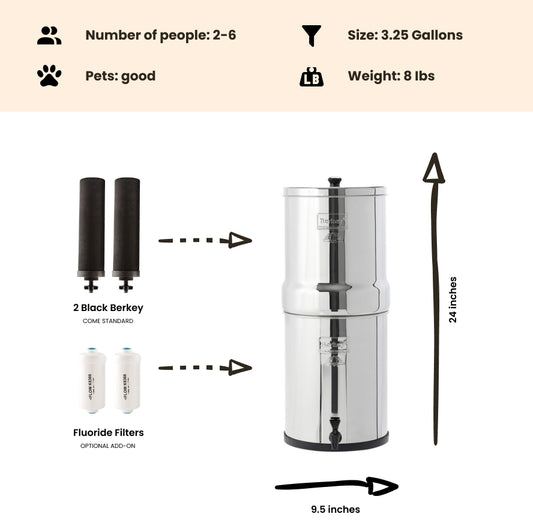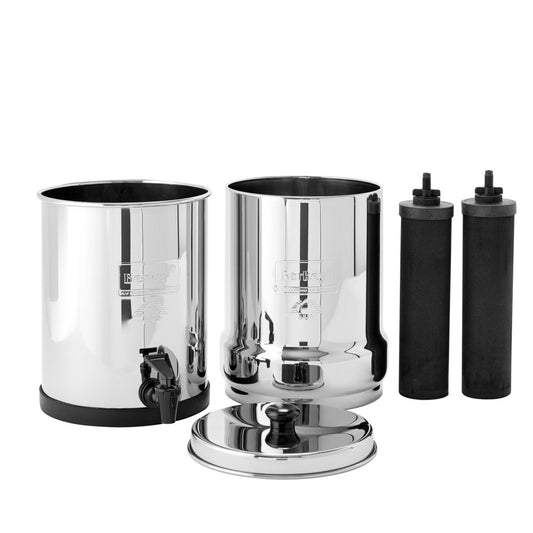Rainwater & Stormwater Harvesting for Climate Resilience
By Dan DeBaunShare
Past weather records and future climate projections show that freshwater resources are extremely vulnerable to climate change. As global temperatures are expected to rise further still, together with a shift in rainfall patterns, both water availability and water quality are likely to be adversely affected.
A Note on Berkey: When if comes to harvesting and filtering rain water, we caution that that the Berkey may not be tested for all the ground and/or roofing materials the water may be coming in contact with. As a result, we recommend the end-user make an effort determine this potential water contact and compare this to what the Berkey has been tested to remove.
Changes in rainfall patterns will significantly alter stream flow rates. Lower rainfall will cause runoff events to occur less frequently, and the amount of water that runs off surfaces into streams on these occasions will be much less. In addition, some areas may experience more frequent or extended periods of drought, resulting in drier soils and a reduced annual stream flow in those catchments. Sporadic flooding events may increase peak flow rates, while changes in wet season may alter the timing of peak flow. All the above factors will adversely impact the availability and quality of water, as well as the reliability of the water supply for meeting the water demands of various sectors that depend on that supply for their livelihood or survival. Clearly we need to make a plan if we hope to survive in the future ahead. So what are our options?
Essentially there are two main sources of runoff that can be harvested for reuse: runoff from roofs (roof water), and runoff from ground surfaces (storm water). There are subtle differences in both the quality and microbial composition of these sources, as well as they way in which they are harvested. Rainwater harvested from roof tops is typically decentralized, where individual homeowners take responsibility for managing the collection, storage and treatment of rainwater collected off the roofs of the structures on their property. By comparison, the collection, storage and treatment of storm water in large surface or underground reservoirs for reuse takes a centralized approach.
Harvesting rainwater can reduce a household's water consumption by as much as a third, particularly if this water is used inside the home rather than purely for outdoor use — that's a substantial water saving that also equates to significant financial savings when the household water bill arrives. If every home were to harvest rainwater, overall consumption would be significantly reduced, alleviating pressure on stressed water resources.
Untreated rainwater poses a very low health risk when used for non-potable purposes. While health studies suggest the health risks of ingesting untreated rainwater are low, harmful pathogens or chemicals can potentially be washed- or leached off roof surfaces to contaminate the water. It is therefore advisable to filter or treat harvested rainwater appropriately before using it for drinking.
A major constraint in centralized storm water harvesting is the availability of suitably large spaces to store large volumes of water collected from sporadic rainfall events. This is particularly problematic in densely populated urban areas where vacant real estate is scarce and consequently in high demand, and where large spaces typically have large price tags.
An alternative is to utilize existing underground aquifers to store storm water that has been appropriately treated. Or to put it another way, to recharge existing groundwater supplies with treated storm water — a practice referred to as 'managed aquifer recharge' (MAR). Essentially, it involves channeling treated storm water or wastewater into natural underground aquifers, which speeds up the rate at which groundwater supplies are recharged. This groundwater is then available for reuse as and when needed.
As storm water harvesting is a relatively new concept, there are very few scientifically based guidelines on storm water reuse and good practice to protect public health. Considering that all manner of pollutants can wash off roads and pavements to enter the stormwater system, some form of treatment is necessary to ensure public health and safety. The World Heath Organization (WHO) currently has guidelines available for the safe reuse of treated wastewater, but this does not yet include storm water harvesting and reuse. It is imperative that safety guidelines for storm water harvesting are developed and made available so that this relatively untapped and under-utilized resource can be more fully exploited to supplement urban water supplies.
-
Regular price $234.00 USDRegular priceUnit price / per
-
Regular price $327.00 USDRegular priceUnit price / per
-
Regular price From $367.00 USDRegular priceUnit price / per
-
Regular price From $408.00 USDRegular priceUnit price / per
-

 Sold outRegular price From $451.00 USDRegular priceUnit price / per
Sold outRegular price From $451.00 USDRegular priceUnit price / per -
Regular price From $478.00 USDRegular priceUnit price / per
-
Regular price $332.50 USDRegular priceUnit price / per
$350.00 USDSale price $332.50 USDSale

Dan DeBaun is the owner and operator of Big Berkey Water Filters. Prior to Berkey, Dan was an asset manager for a major telecommunications company. He graduated from Rutgers with an undergraduate degree in industrial engineering, followed by an MBA in finance from Rutgers as well. Dan enjoys biohacking, exercising, meditation, beach life, and spending time with family and friends.
~ The Owner of Big Berkey Water Filters
















